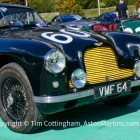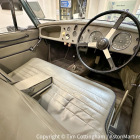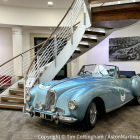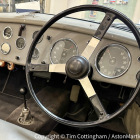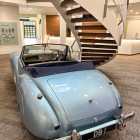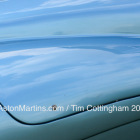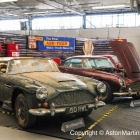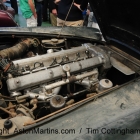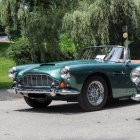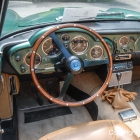Whilst the introduction of the convertible was simultaneous with the series 4 saloon, all examples have the longer body associated with the series 5 cars. The greater distance between the rear wheel arch and rear bumper is indicative of a total length of 457cm – 15 feet. Also a look at the chassis number range makes it also appear that all the convertibles are ‘series 5’. But the earlier cars do have typical series 4 front indicators, side lights and tail lights. All examples have opening front quarterlights, a feature not seen on the equivalent saloon until the introduction of the DB6. The chassis of the DB4 convertible was also necessarily stiffened to compensate for the loss of the stiffening roof section.
One wonderful and attractive feature of the interior of the convertible is that many have the dashboard painted body colour instead of the simple dark grey used on the saloon.
The folding roof was manually operated and covered with Everflex although this is often replaced with mohair during restoration. A few later cars were supplied with an optional factory hardtop, an expensive £200 option and very rarely seen. Yet I was fortunate to photograph an example, in the rain at the Newport Pagnell factory in May 2004.
Only 70 of these most elegant of cars were ever built (30 in series 4 and 40 in series 5) out of a total DB4 production of 1110 cars. Many cars were fitted with the /SS Special Series engine with triple SU carbs (see DB4 Vantage) but only two received the faired-in headlights of the Vantage, one of these a GT engine.
Perhaps the most famous DB4 Convertible is 163ELT, finished in Snow Shadow Grey with a red interior. This was the car driven in the film “The Italian Job” by Michael Caine, but thankfully not actually pushed over the cliff. The film company substituted a converted Lancia for that part of the film.
Needless to say, the DB4 convertible is a very rare and beautiful car, one of the rarest of the cars made during the David Brown era. When examples reach the market, the prices asked most certainly reflect this at around double that over an equivalent DB4 saloon. A now a polite additional note: under no circumstances should the DB4 convertible be called a Volante; the Volante model wasn’t introduced until 1965.
Originally owned by the legendary Academy Award-winning actor, playwright and diplomat Sir Peter Ustinov, this ultra-rare DB4 Vantage Convertible (below) was delivered to him at the Montreux Palace Hotel in Switzerland in 1962. In May 2015, at the Bonhams Aston Martin sale, it was sold for £1.5 million, a world record price for the model.
Thanks to Kean Rogers for some assistance with this page.




